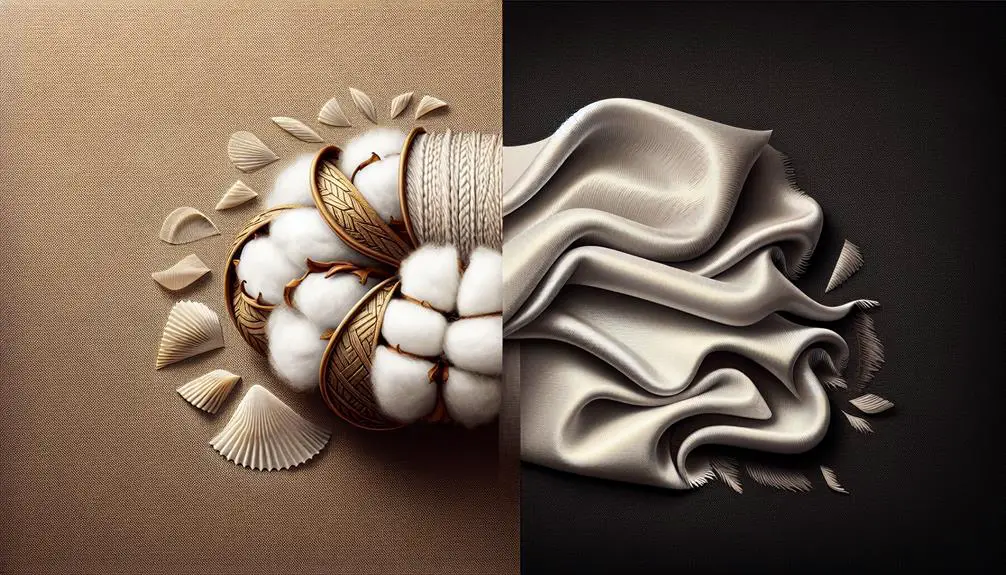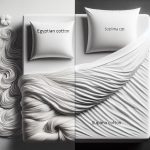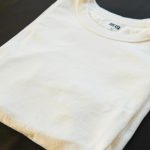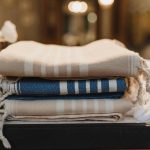Did you know that Pima cotton, also known as Supima, represents only about 3% of the cotton grown globally?
The distinction between Pima and Egyptian cotton may seem subtle, but it can make a significant difference in the quality of your linens.
When it comes to choosing between these two luxurious fabrics, understanding their unique characteristics and benefits is key.
Let's explore the world of Pima versus Egyptian cotton and unravel the mysteries behind these sought-after materials.
Table of Contents
Key Takeaways
- Pima cotton is prized for its durability and softness, while Egyptian cotton offers a luxurious, velvety touch.
- Egyptian cotton excels in moisture retention, ideal for items like towels needing high absorbency.
- Egyptian cotton maintains vibrant colors with superior color retention, making it a long-term investment.
- Pima cotton boasts a rich, lustrous appearance with a glossy finish, providing a luxurious feel.
Origins and Cultivation
When it comes to Pima vs Egyptian cotton, understanding the origins and cultivation of these two cotton varieties sheds light on their unique qualities and characteristics.
Pima cotton, mainly grown in the United States, particularly in Arizona, is renowned for its long fibers that result in durable and soft products.
On the other hand, Egyptian cotton hails from Egypt, along the fertile lands of the Nile River, benefitting from a unique climate and soil that produce some of the finest and most luxurious cotton materials available.
Pima cotton's resistance to wrinkling and pilling makes it a preferred choice for high-quality bed sheets and textiles. Conversely, Egyptian cotton, with its long staple fibers, is celebrated for its strength, softness, and ability to withstand stress and pilling, growing even softer with each wash.
This distinction in cultivation regions plays a significant role in the characteristics and quality of the final cotton products, influencing consumers in choosing the right cotton type based on their preferences for softness and durability.
Fiber Characteristics
Hey there! Let's talk about the fiber characteristics of Pima and Egyptian cotton.
We'll compare their strength, absorbency, and feel to help you understand which one suits your needs best.
Get ready to discover the standout features of these two luxurious cotton types!
Fiber Strength
Pima cotton stands out for its exceptional fiber strength and durability, making it a reliable choice for products requiring long-lasting quality. While Egyptian cotton boasts a higher tensile strength, Pima fibers are renowned for their smooth texture and resilience against wear and tear. Let's compare these cotton varieties side by side:
| Fiber Characteristic | Pima Cotton | Egyptian Cotton |
|---|---|---|
| Strength | Less prone to breakage | Higher tensile strength |
| Durability | Resistant to wear and tear | More robust and resilient |
| Smooth Texture | Natural sheen, luxurious feel | Fine and silky touch |
| Long Fibers | – | Exceptionally long |
| Softness | Soft and comfortable | Superior softness |
Both cotton types have unique strengths, but Pima cotton's durability and softness make it a preferred choice for long-lasting products.
Absorbency Comparison
Comparing the liquid absorbency rates of Egyptian cotton and Pima cotton reveals distinct advantages based on their fiber characteristics. Egyptian cotton, with its longer staple fibers, excels in moisture retention, making it superb for items like towels and linens that require high absorbency.
On the other hand, Pima cotton, while slightly less absorbent than Egyptian cotton, offers a good balance between absorbency and breathability. This makes Pima cotton a versatile choice for various applications such as clothing and bedding where managing moisture is crucial.
If you seek exceptional absorbency and moisture retention, Egyptian cotton is the go-to option. However, if you prefer a fabric that strikes a balance between absorbency and breathability, Pima cotton is an excellent choice.
Texture and Feel
When it comes to the feel and texture of cotton fabrics, the characteristics of Pima and Egyptian cotton stand out distinctly based on their fiber composition.
Here's what sets them apart:
- Silky Smoothness: Pima cotton is prized for its softness and durability, offering a slightly crisp feel compared to the luxurious, velvety touch of Egyptian cotton.
- Long Fiber Advantage: The long fibers of Pima cotton contribute to its silky feel and smooth texture, while Egyptian cotton's longer staple fibers enhance its superior softness and plush feel.
- Indulgent Comfort: Egyptian cotton is often considered more indulgent and velvety in texture and feel, making it a popular choice for those seeking exceptional comfort in their bedding.
Softness and Comfort
With its renowned extreme softness, Egyptian cotton stands out for its luxurious feel compared to Pima cotton. The longer staple fibers in Egyptian cotton make it exceptionally soft and plush, providing a silky smooth texture that enhances comfort levels. When you run your hand over Egyptian cotton sheets or clothing, you can feel the difference – it's like wrapping yourself in a cloud of softness.
On the other hand, Pima cotton, although also soft, falls slightly behind Egyptian cotton in terms of luxuriousness. It offers a cozy and gentle touch that many people find comforting, making it a popular choice for everyday items like t-shirts and bedding. While Pima cotton is undeniably comfortable, those seeking the ultimate softness and opulence often opt for Egyptian cotton for its superior feel.
In the realm of softness and comfort, Egyptian cotton takes the lead with its unmatched luxuriousness and pampering sensation. Whether you're lounging in Egyptian cotton pajamas or drifting off to sleep on Egyptian cotton sheets, the experience is bound to be indulgently comfortable.
Durability and Longevity
Moving from the realm of softness and comfort, let's now explore the durability and longevity of Pima and Egyptian cotton, highlighting their exceptional staying power in the realm of bedding and clothing.
- Staple Fibers: Pima cotton and Egyptian cotton are both known for their long staple fibers, which contribute to their durability and longevity. These longer fibers make the fabric stronger and more resistant to pilling and fraying, ensuring that your bedding and clothing maintain their quality over time.
- Proper Care and Maintenance: Both Pima and Egyptian cotton require proper care and maintenance to ensure their longevity. Washing them in cold water, using gentle detergents, and avoiding harsh chemicals can help preserve the fibers and prevent premature wear. Additionally, following manufacturer's instructions for drying and ironing can further extend the lifespan of these premium cotton fabrics.
- Investment in Quality: While Pima and Egyptian cotton products may come at a higher initial cost, their exceptional durability makes them worthwhile long-term investments. Their ability to maintain softness, color, and shape over many uses sets them apart as top choices for those seeking bedding and clothing that last.
Color Retention and Appearance
So, let's chat about how Egyptian and Pima cotton are rockstars at holding onto colors.
Egyptian cotton is like a color-locking magician, keeping those vibrant hues alive wash after wash.
Pima cotton doesn't fall behind either, holding onto its rich tones and appearance like a champ.
Color Retention Comparison
Both Egyptian and Pima cotton showcase impressive color retention, ensuring that the vibrant hues of the fabrics remain intact even after multiple washes. The high-quality fibers in both types of cotton play a significant role in preserving the colors of the fabric, making them resistant to fading over time.
Here are three key points to consider in the color retention comparison:
- Egyptian cotton is renowned for its exceptional color retention properties, maintaining the richness of its colors even after numerous washes.
- Pima cotton also excels in color retention, ensuring that the fabric retains its original hues over extended periods.
- Both Egyptian and Pima cotton fabrics are known for their ability to resist fading, making them durable choices for long-lasting bedding.
Appearance Differences Explained
With their distinct characteristics in color retention and appearance, Egyptian and Pima cotton offer unique qualities that elevate the aesthetic appeal of bedding and textiles.
Egyptian cotton stands out for its superior color retention, keeping colors vibrant even after numerous washes. Its fibers create a smooth and consistent fabric appearance, enhancing the overall look of the material.
On the other hand, Pima cotton boasts a rich, lustrous appearance that adds a luxurious touch to fabrics. The natural sheen of Pima cotton gives it a glossy finish, contributing to its elegant and high-end appearance.
While Egyptian cotton showcases unmatched color depth and brilliance, Pima cotton's sheen and luster make it a popular choice for those seeking a sophisticated and refined look in their textiles.
Pricing and Value
When comparing Pima and Egyptian cotton in terms of pricing and value, it's evident that Egyptian cotton, known for its superior quality and luxurious feel, typically comes at a higher cost than Pima cotton. Here are some key points to consider:
- Luxury Comes at a Price: Egyptian cotton is often associated with luxury due to its exceptional quality and feel, leading to a higher price point compared to Pima cotton.
- Value for Money: While Egyptian cotton may be pricier, Pima cotton offers excellent value for its quality. It's slightly more affordable than Egyptian cotton but still maintains a reputation for softness and durability.
- Long-Term Investment: The higher price of Egyptian cotton reflects its durability and longevity, making it a worthwhile investment for those looking for bedding or clothing that will last for years to come.
Frequently Asked Questions
Which Cotton Is Better Pima or Egyptian?
When deciding between Pima and Egyptian cotton, I consider factors like softness, durability, and budget. Each has its strengths—whether opting for luxurious softness or a balance of quality and cost, it's about personal preferences.
Is Pima Cotton Really Better?
Oh, you bet Pima cotton is really better! Soft, durable, and resistant to wrinkles – it's like the superhero of fabrics. Once you try it, there's no going back. Trust me.
Which Is Better Pima or Supima Cotton?
I think Supima cotton is superior to regular Pima. It's top-notch quality, super durable, and has strict standards for length and strength. Plus, products made with Supima are softer, more breathable, and pill-resistant.
What Is the Highest Quality of Cotton?
I'll tell you, Egyptian cotton reigns as the pinnacle of cotton perfection. Its long fibers, unmatched softness, and strength make it the top choice. When it comes to quality, Egyptian cotton stands tall.
- Recycling Nonwoven Fabrics: Is It Possible? - July 11, 2025
- Recycling Nonwoven Fabrics: Is It Possible? - July 11, 2025
- Recycling Nonwoven Fabrics: Is It Possible? - July 11, 2025







